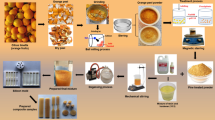Abstract
For the sake of the safe and efficient cyclic utilization of chrome leather shavings (CLS), the temporary stabilization of CLS during the storage and transport processes was optimized. Afterwards, the large-scale stabilized CLS degradation and collagen degradation product (CDP) extraction were completed. In this research, hydroxyapatite (HAP) and calcium hydroxide (Ca(OH)2) were for the first time used as stabilizers in the stabilization of CLS. The results showed that both Ca(OH)2 and HAP displayed resistance to chrome leaching, but HAP provided better stabilization effect than Ca(OH)2. The optimized stabilization conditions giving lower chromium leaching concentration were selected: 2% HAP, temperature 300 °C, reaction time 60 min, and initially added water contents of 50%. The reason for HAP and Ca(OH)2 stabilization was proved by energy dispersive X-ray spectroscopy (EDS). Subsequently, the exploitation value of the stabilized CLS was described by large-scale experiment. The hydrolysis of stabilized CLS could obtain the collagen degradation product (CDP), which had 3.52% of free amino content and a molecular weight of 3.4~30 kDa. The filter residue was treated by 5% sulfuric acid solution extraction and pressure filtration again. The extraction solution and final filter residue were dried separately to obtain chromium-containing organic compounds (COP) and industrial gypsum. The COP, used as a filling for tannery, contains 9.37% Cr2O3 content and 90.6% organic content. The industrial gypsum contains 68.37% CaSO4, 0.13% Cr2O3, and 31.5% residual organic or inorganic compounds, which can be used in building materials. No waste water or solid waste was discharged in this experiment process.







Similar content being viewed by others
References
Avudainayagam S, Megharaj M, Owens G, Kookana RS, Chittleborough D, Naidu R (2002) Chemistry of chromium in soils with emphasis on tannery waste sites. Rev Environ Contam Toxicol 178:53–91
Basegio T, Haas C, Pokorny A, Bernardes AM, Bergmann CP (2006) Production of materials with alumina and ashes from incineration of chromium tanned leather shavings: environmental and technical aspects. J Hazard Mater 137(2):1156–1164
Chen Q (2014) Study on reutilization of wet-blue leather wastes for the production of regenerated leather composite. J Am Leather Chem As. 109(11):372–379
Dhayalan K, Fathima NN, Gnanamani A, Rao JR, Nair BU, Ramasami T (2007) Biodegradability of leathers through anaerobic pathway. Waste Manag 27(6):760–767
Ding C, Zhang M, Dai L, Qi Y, Shi R, Yang J (2017) Fabrication and characterization of regenerated leather using chrome shavings as raw materials. J Am Leather Chem As 112(5):145–152
Dixit S, Yadav A, Dwivedi PD, Das M (2015) Toxic hazards of leather industry and technologies to combat threat: areview. J Clean Prod 87:39–49
DNI53314 (n.d.) Leather detection. detection of Cr(VI) in leather [S]
HJ 557-2009–(2010) Solid waste-Extraction procedure for leaching toxicity- Horizontal vibration method (in Chinese) [S]
Kamaraj C, Lakshmi S, Rose C (2016) Experimental study on micro surfacing using chrome shaving impregnated with modified bitumen emulsion. J Sci Ind Res India 75(6):378–382
Kocurek P, Kolomazník K, Barinová M (2015) Dechroming spent tanning liquor using filtration cake from enzymatic hydrolysis og chrome shavings. J Soc Leather Technol Chem 99(6):288–292
Kocurek P, Kolomazník K, Bařinová M, Hendrych J (2017) Total control of chromium in tanneries- thermal decomposition of filtration cake from enzymatic hydrolysis of chrome shavings. Waste Manage Res 35(4):444–449
Koki IB, Jimoh WLO (2015) Assessment of heavy metals in tannery solid waste from Challawa industrial estate, Kano state, Nigeria. Int J Res Environ Stud 2:33–40
Kolomaznik K, Adamek M, Andel I, Uhlirova M (2008) Leather waste—potential threat to human health, and a new technology of its treatment. J Hazard Mater 160(2):514–520
Konikkara N, Kennedy LJ, Vijaya JJ (2016) Preparation and characterization of hierarchical porous carbons derived from solid leather waste for supercapacitor applications. J Hazard Mater 318:173–185
Lakrafli H, Tahiri S, Albizane A, Otmani MEE (2012) Effect of wet blue chrome shaving and buffing dust of leather industry on the thermal conductivity of cement and plaster based materials. Constr Build Mater 30(1):590–596
Losi ME, Amrhein C, Frankenberger JRWT (1994) Environmental biochemistry of chromium. Rev Environ Contam Toxicol 136:91–131
Malek A, Hachemi M, Didier V (2009) New approach of depollution of solid chromium leather waste by the use of organic chelates: economical and environmental impacts. J Hazard Mater 170:156–162
Mohamed OA, Taha GM, Elsayed NH (2013) Technical gelatine from chrome tanned shavings. Int J Environ Waste Manag 11(4):335–349
Murugan KP, Kumar MSG, Krishnan KS, Kumar VV, Kumar SA, Swarnalatha S (2018) Production of Asphaltene binders from solid waste generated in leather industry. Water Sci Technol:407–419. https://doi.org/10.1007/978-981-10-5795-3_34
Pati A, Chaudhary R, Subramani S (2013) Biochemical method for extraction and resue of protein and chromium from chrome leather shavings. J Am Leather Chem As. 108(10):365–372
QB/T 1274–(2012) Fur-chemical tests-Determination of total ash (in Chinese) [S]
Qiang XH, Feng H (2011) Collagen extracted from chrome shavings using alkali and enzyme. International conference on remote sensing, environment and transportation. Engineering:5810–5813. https://doi.org/10.1109/RSETE.2011.5965675
Shanth C, Banerjee P, Chandra Babu NK, Rajakumar G (2013) Recovery and characterization of protein hydrolysate from chrome shaving by microbial degradation. J Am Leather Chem As. 108(6):231–239
Tang YL, Hu ZY, Liu HY et al (2014) Cyclic Dechroming process for chrome shavings by coordination substitution reaction and Photocatalysis. J Am Leather Chem Assoc 109(11):380–388
USEPA (1990) Toxicity Characterisation Leaching Procedure (TCLP), EPA Method 1311, Washington, US, [S]
Wang H, Zhang S, Pan LI, Yang H, Wang X, Chen H (2014) Effects of temperature on pyrolysis products and characteristiCLS of chrome shavings. Ciesc J CIESC J 65(8):3152–3158
Wang S, Yamg M, Zhang YW et al (2017a) Degraded collagen-melamine compound and its powder performance. J Chem Eng Chin Univ 31(4):996–1000
Wang S, Yang M, Yue Z, Zhijun C, Zhihua S (2017b) Degraded-collagen/melamine composites and their powder properties. J Chem Eng Chin Univ 31(4):996–1000
Wells HC, Sizeland KH, Edmonds RL, Aitkenhead W, Kappen P, Glover C, Johannessen B, Haverkamp RG (2014) Stabilizing chromium from leather waste in biochar. ACS Sustain Chem Eng 2(7):1864–1870
Wionczyk B, Apostoluk W, Charewicz WA, Adamski Z (2011) Recovery of chromium(III) from wastes of uncolored chromium leathers. Part I. kinetic studies on alkaline hydrolytic decomposition of the wastes. Sep Purif Technol 81:223–236
Yi J, Chen H, Shan ZH (2013) Reconstituted leather made using a Core-Shell Polyacrylate adhesive. J Soc Leath Tech Ch 97(2):74–79
Ying G, Liu X, Li H, Chen W (2010) Stabilization of chromium: an alternative to make safe leathers. J Hazard Mater 179(1):540–544
Acknowledgments
This project is supported by the Fuxin Hazardous Waste Treatment Station of Liaoning Province, China, and the Key Laboratory of Leather Chemistry and Engineering of the Ministry of Education of Sichuan University.
Author information
Authors and Affiliations
Corresponding author
Additional information
Responsible editor: Philippe Garrigues
Rights and permissions
About this article
Cite this article
Yang, J., Shan, Z., Zhang, Y. et al. Stabilization and cyclic utilization of chrome leather shavings. Environ Sci Pollut Res 26, 4680–4689 (2019). https://doi.org/10.1007/s11356-018-3687-2
Received:
Accepted:
Published:
Issue Date:
DOI: https://doi.org/10.1007/s11356-018-3687-2




